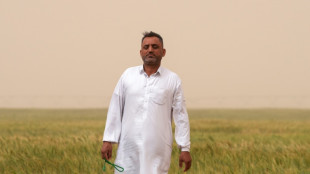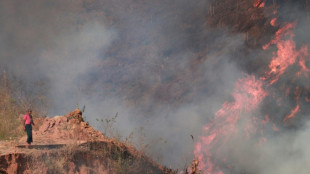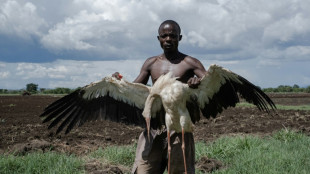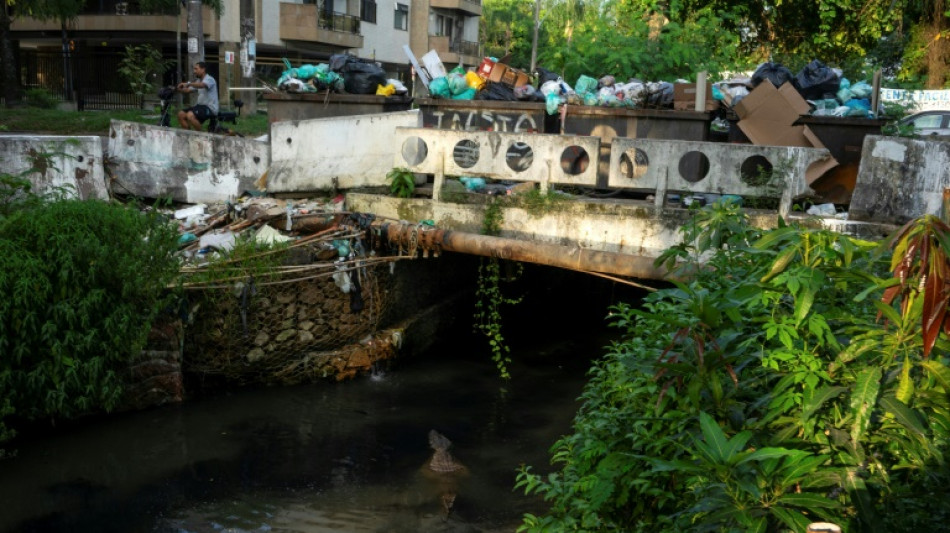
-
 Indian army says new exchange of gunfire with Pakistan
Indian army says new exchange of gunfire with Pakistan
-
Epstein accuser Virginia Giuffre takes own life in Australia: family

-
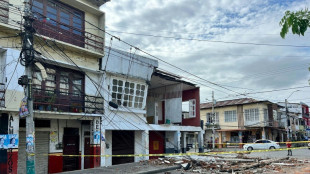 Hundreds of buildings damaged, dozens injured in 6.3 Ecuador quake
Hundreds of buildings damaged, dozens injured in 6.3 Ecuador quake
-
India and Pakistan's Kashmir fallout hits economy too

-
 Francis's funeral to be grand farewell to 'pope of the poor'
Francis's funeral to be grand farewell to 'pope of the poor'
-
Pogacar faces defiant Evenepoel at Liege-Bastogne-Liege

-
 Chelsea eye great escape against Barcelona in Women's Champions League
Chelsea eye great escape against Barcelona in Women's Champions League
-
Iran, US to hold new round of high-level nuclear talks

-
 'Energy and effort' pay off for Reds as Blues' woes continue
'Energy and effort' pay off for Reds as Blues' woes continue
-
Albatross and closing birdie lift China's Liu to LPGA Chevron lead

-
 On the horizon? Wave of momentum for high seas treaty
On the horizon? Wave of momentum for high seas treaty
-
Developing countries should fast-track US trade deals: World Bank president

-
 Grizzlies' Morant 'doubtful' for must-win game 4 v Thunder
Grizzlies' Morant 'doubtful' for must-win game 4 v Thunder
-
Trump in Rome for pope funeral in first foreign trip of new term

-
 Trump says Russia-Ukraine deal 'very close' after new Kremlin talks
Trump says Russia-Ukraine deal 'very close' after new Kremlin talks
-
US rookies lead PGA pairs event with McIlroy and Lowry in hunt

-
 Trump tariff promises get a reality check
Trump tariff promises get a reality check
-
Warriors coach Kerr 'relatively optimistic' injured Butler will play game 3

-
 Postecoglou hopes 'Stonecutter's Credo' can inspire Spurs
Postecoglou hopes 'Stonecutter's Credo' can inspire Spurs
-
PSG lose unbeaten Ligue 1 record ahead of Arsenal showdown

-
 Venezuela accuses El Salvador president of 'human trafficking'
Venezuela accuses El Salvador president of 'human trafficking'
-
Own goal takes Sundowns to African final against Pyramids

-
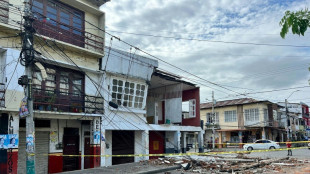 Scores of buildings damaged, 20 injured in Ecuador quake
Scores of buildings damaged, 20 injured in Ecuador quake
-
US stocks extend rally as market eyes busy calendar next week
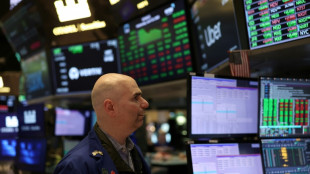
-
 Pope's death triggers surge of disinformation he fought against
Pope's death triggers surge of disinformation he fought against
-
Rovanpera takes control of Rally Islas Canarias

-
 Zelensky insists Crimea is Ukrainian as US envoy meets Putin
Zelensky insists Crimea is Ukrainian as US envoy meets Putin
-
Patel and Mendis help Sunrisers beat Kings in Dhoni's 400th T20

-
 Copa del Rey ref statements 'unacceptable': Real Madrid after boycotting final build-up
Copa del Rey ref statements 'unacceptable': Real Madrid after boycotting final build-up
-
Insurance CEO's accused killer pleads not guilty to federal murder charges

-
 FBI arrests Wisconsin judge for shielding undocumented migrant
FBI arrests Wisconsin judge for shielding undocumented migrant
-
Brazil ex-president Collor de Mello jailed for corruption

-
 Zelensky insists Crimea 'belongs' to Ukraine as US envoy meets Putin
Zelensky insists Crimea 'belongs' to Ukraine as US envoy meets Putin
-
Real Madrid boycott Copa del Rey build-up over referee complaints

-
 Trinidad and Tobago votes for parliament, PM, with opposition in lead
Trinidad and Tobago votes for parliament, PM, with opposition in lead
-
IMF chief hails 'constructive' Spring Meetings held under tariff uncertainty

-
 Iran FM Araghchi in Oman ahead of nuclear talks with US
Iran FM Araghchi in Oman ahead of nuclear talks with US
-
Dozens of buildings destroyed, 20 injured in Ecuador quake
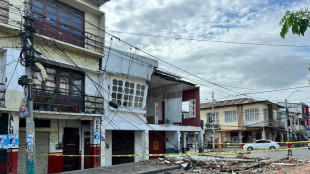
-
 Young Barca must 'enjoy' Real Madrid Copa final fight: Flick
Young Barca must 'enjoy' Real Madrid Copa final fight: Flick
-
Pakistan and India border closure separates families
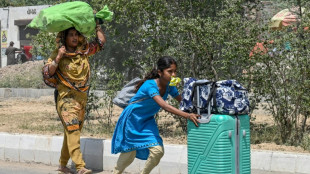
-
 Brazil's Bolsonaro 'stable' after post-surgery setback
Brazil's Bolsonaro 'stable' after post-surgery setback
-
Catholics in secular Cuba hail Francis as 'bridge'

-
 US envoy Witkoff, Putin discuss 'possibility' of direct Russia-Ukraine talks
US envoy Witkoff, Putin discuss 'possibility' of direct Russia-Ukraine talks
-
Community seeks answers after French school knife killing

-
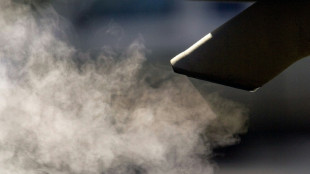 German prosecutors seek jail terms in VW 'dieselgate' trial
German prosecutors seek jail terms in VW 'dieselgate' trial
-
Sabalenka makes winning start at Madrid Open

-
 EU, US should de-escalate and negotiate trade deal: IMF Europe director
EU, US should de-escalate and negotiate trade deal: IMF Europe director
-
Russia accuses Ukraine of killing general in car bombing

-
 Emery wants FA Cup glory and Champions League berth for Villa
Emery wants FA Cup glory and Champions League berth for Villa
-
Buildings destroyed, one injured in Ecuador quake
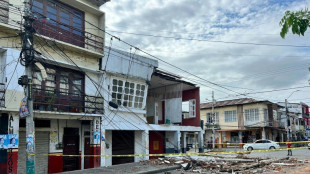

Brazil caimans fight to survive in polluted Rio waters
Intrepid as Crocodile Dundee, Brazilian biologist Ricardo Freitas catches a caiman in the dark of night with a snare pole, then hoists it into his small wooden boat.
Unfazed by the reptile's sharp teeth, he grabs it by the snout and wraps a black band around its muzzle to examine it without getting bitten.
The 1.5-meter (five-foot) caiman is right at home in the lagoon waters of Jacarepagua, a vast, urban district on Rio de Janeiro's west side whose name means "Valley of the Caimans" in the Tupi-Guarani Indigenous language.
Despite the name, there is little trace in Jacarepagua these days of verdant valley or tropical forest: it is increasingly a concrete jungle, with upmarket high-rises surrounding the lagoon and tens of thousands of residents' waste water emptying into it.
Freitas's boat floats on the foul-smelling water directly in front of the sprawling Olympic village from the 2016 Rio Games.
The 44-year-old biologist fears for the future of this ancient species in a world of rampant urbanization: "They're threatened with extinction," he says.
- Swallowed trash and condoms -
Freitas estimates the region is home to around 5,000 broad-snouted caimans (Caiman latirostris).
The largest grow to more than three meters long.
One major threat to their survival: 85 percent of the specimens he examines are males, an imbalance he blames on pollution.
"Caimans are laying their eggs in extremely polluted areas, where the water temperature is higher. That makes it more likely the offspring will be males," he says.
"It's a species where sex is determined by the incubation temperature of the eggs... Here, the water is a lot warmer because of all the decomposing materials."
That threatens the entire ecosystem, not just the caimans, he adds.
"Since (caimans) are at the top of the food chain, they are key to maintaining equilibrium between species. Without caimans, the area's biodiversity would be completely compromised."
Freitas, who has a PhD in ecology, has been studying these waters for more than 20 years.
The head of a small conservation group called the Jacare Institute, he has captured and logged data on more than 1,000 caimans.
Aboard his boat, he weighs, measures and takes scale samples from the reptiles to analyze them for levels of contamination from lead, mercury and other heavy metals.
He also pumps their stomachs to see what they have been eating.
"I've found all kinds of waste: plastic bags, pieces of cans, bottle caps, even condoms," he says.
- 'State of abandonment' -
Rampant urbanization has steadily reduced the caimans' native habitat, drawing them into polluted residential areas in search of food.
In a canal through the Terreirao, a working-class neighborhood, caimans are literally swimming in refuse.
One peeks out just its snout through a carpet of waste in the water, including a dismembered doll and a deflated football.
"It's sad to see them in the middle of all this pollution. It's a little scary to live so close to them, but they almost never leave the water," says 34-year-old resident Regina Carvalho, a preschool assistant.
When the canal floods, locals sometimes find themselves nose to nose with the wild animals.
But shopkeeper Alex Ribeiro, 58, says he has "never heard any talk of attacks."
"Everything is in a state of abandonment here, with makeshift sewage pipes from people's houses emptying into the canal," he says.
"You can imagine the level of pollution the caimans are exposed to."
C.Garcia--AMWN

